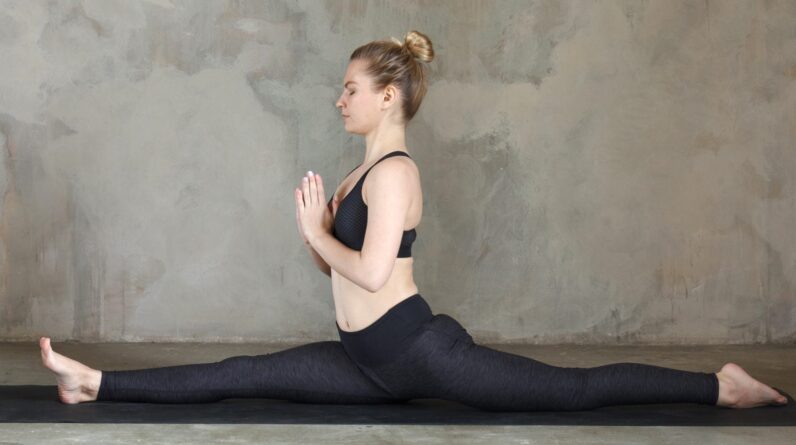
Hanumanasana offers several benefits for your health. Here are the benefits of monkey pose and how to do it.
Hanumanasana, also known as the monkey pose, is named after the Hindu god Hanuman. The name “Hanumanasana” is derived from Hindu mythology, and combines the words “Hanuman,” which means monkey, and “asana,” which means seat or posture. The monkey pose is also called the split pose. This pose symbolises strength, flexibility, immense prowess, and trust. This pose helps to open up the hips and stretches muscles in the groin and hamstring region. Here are the notable benefits of hanumanasana and how to do the monkey pose.
What are the benefits of hanumanasana or monkey pose?
Here are some of the potential benefits of hanumanasana or monkey pose.
1. Improves muscle strength and flexibility
According to a study published in the International Journal of Environmental Research and Public Health, yoga has moderately positive effects on muscle strength, balance, mobility, and lower body flexibility. Including hanumanasana may help to enhance muscle strength, flexibility, agility, and endurance. Agility refers to a muscle’s capacity to quickly change position. Endurance refers to a muscle’s ability to contract against a force over time.

2. Helps to maintain heart rate
Hanumanasana as part of a yoga routine may aid with heart rate regulation. However, more research is needed to determine whether hanumanasana can help to maintain the heart rate. If you have an abnormal heart rate, you should immediately stop doing the pose and it is advisable to perform the pose under the supervision of a professional.
3. Improves mental health
If you are looking for ways to reduce anxiety and stress, try incorporating monkey pose or hanumanasana into your fitness regime. This yoga pose helps to calm your mind, by reducing anxiety and keeping stress at bay. Overall, this yoga pose helps to improve mental health. According to a study published in the International Journal of Academic Medicine and Pharmacy, including yoga in your daily routine helps to reduce stress and enhances your overall mental health.
Also Read

4. Aids in balancing chakras
“At the spiritual ground, hanumanasana opens the root chakra (Mooldhara) and the sacral or spleen chakra (Svadhisthana). The root chakra fosters personal growth, whereas the sacral chakra encourages focus, creativity, and inner acceptance,” explains the yoga expert, Dr Hansaji Jayadeva Yogendra.
5. Reduces heart disease risk
A high BMI (body mass index) can pose a risk to the heart and disrupt its function. BMI is a measure of body fat based on height and weight. A yoga practice that incorporates hanumanasana may help lower BMI and reduce the risk of heart disease, according to a study published in the Journal of Dental and Medical Sciences. However, more research is needed to determine whether monkey pose can help with heart conditions.
How to keep your heart and brain healthy? Check out these 5 yoga poses
6. Helps stimulate abdominal organs
“Regular practice of monkey pose will not only help improve your digestion but also promote the healthy functioning of your reproductive organs. So, if you are looking to enhance your overall health and well-being, adding hanumanasana to your yoga routine can be beneficial,” says the expert.
How to do the monkey pose or hanumanasana?
Here is a complete guide to doing the monkey pose or hanumanasana, as explained by the expert.
Entering the pose
- Begin on your hands and knees in a tabletop position. Push your hips back and straighten your legs to come into adho mukha svanasana (downward dog pose).
- Engage your core, keep your back flat, and press your heels towards the floor.
- Now, lift one leg and step it forward between your hands. Align your front knee directly over your ankle. Square your hips (to have them square means they are in the same plane, both horizontally and vertically) and keep the back of the leg straight, pushing your heel down towards the mat.
- Once comfortable in the lunge, hinge at your hips and raise your torso forward, reaching for your front foot or shin with both hands. Lengthen your spine and avoid hunching your back. If reaching your foot is difficult, hold onto it wherever you feel comfortable.
- Hold hanumanasana for 30 seconds to 1 minute. Breathe deeply and slowly throughout the pose.
- Focus on the sensations in your body. If you feel any sharp pain, ease off the pose or come out of it completely.

Exiting the pose
- Gently push yourself back up to the high lunge position.
- Step the foot back to join your front foot, returning to the Downward-Facing Dog.
- Repeat the pose on the other side.
Things to keep in mind!
It is more important to maintain proper form than to achieve a deep stretch. Keep your hips square and avoid collapsing your lower back.
If a full front split is too far, hold the high lunge position and focus on lengthening your spine forward.
Are there any side effects of hanumanasana or monkey pose?
Hanumanasana is a challenging posture. Even though there are no direct side effects of this asana, it’s best to approach it with patience and under the guidance of a professional who can ensure proper alignment and help you prevent injuries.







